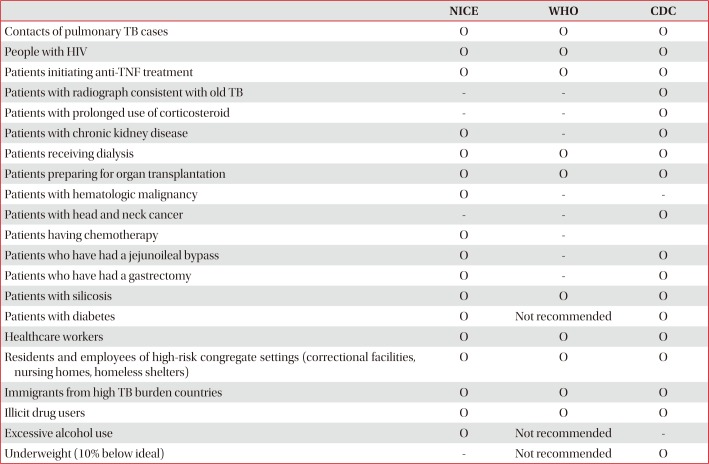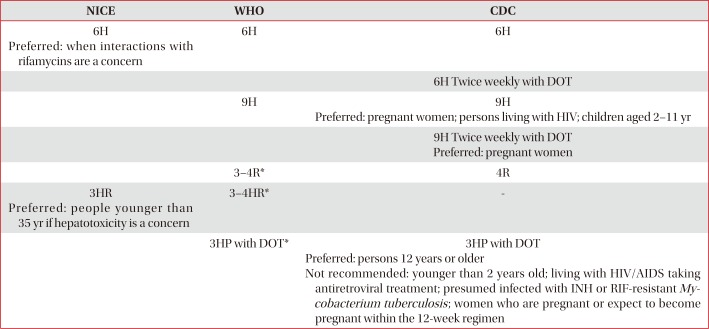1. Ahmad S. Pathogenesis, immunology, and diagnosis of latent
Mycobacterium tuberculosis infection. Clin Dev Immunol. 2011; 2011:814943. PMID:
21234341.
2. Ahmad S. New approaches in the diagnosis and treatment of latent tuberculosis infection. Respir Res. 2010; 11:169. PMID:
21126375.

4. Dye C, Glaziou P, Floyd K, Raviglione M. Prospects for tuberculosis elimination. Annu Rev Public Health. 2013; 34:271–286. PMID:
23244049.

6. Kim JH, Yim JJ. Achievements in and challenges of tuberculosis control in South Korea. Emerg Infect Dis. 2015; 21:1913–1920. PMID:
26485188.

7. Korea Centers for Disease Control and Prevention. Annual report on the notified tuberculosis patients in Korea, 2016. Cheongju: Korea Centers for Disease Control and Prevention;2017.
8. Park YK, Park YS, Na KI, Cho EH, Shin SS, Kim HJ. Increased tuberculosis burden due to demographic transition in Korea from 2001 to 2010. Tuberc Respir Dis. 2013; 74:104–110.

9. Jeong YJ, Yoon S, Koo HK, Lim HJ, Lee JS, Lee SM, et al. Positive tuberculin skin test or interferon-gamma release assay in patients with radiographic lesion suggesting old healed tuberculosis. J Korean Med Sci. 2012; 27:761–766. PMID:
22787371.

10. Small PM, Hopewell PC, Singh SP, Paz A, Parsonnet J, Ruston DC, et al. The epidemiology of tuberculosis in San Francisco: a population-based study using conventional and molecular methods. N Engl J Med. 1994; 330:1703–1709. PMID:
7910661.
11. Mori T, Leung CC. Tuberculosis in the global aging population. Infect Dis Clin North Am. 2010; 24:751–768. PMID:
20674802.

12. Lincoln EM. The effect of antimicrobial therapy on the prognosis of primary tuberculosis in children. Am Rev Tuberc. 1954; 69:682–689. PMID:
13148531.
13. Jenkins D, Davidson FF. Isoniazid chemoprophylaxis of tuberculosis. Calif Med. 1972; 116:1–5.
14. Runyon EH. Preventive treatment in tuberculosis: a statement by the Committee on Therapy, American Thoracic Society. Am Rev Respir Dis. 1965; 91:297–298. PMID:
14253184.
15. Targeted tuberculin testing and treatment of latent tuberculosis infection. This official statement of the American Thoracic Society was adopted by the ATS Board of Directors, July 1999. This is a Joint Statement of the American Thoracic Society (ATS) and the Centers for Disease Control and Prevention (CDC). This statement was endorsed by the Council of the Infectious Diseases Society of America. (IDSA), September 1999, and the sections of this statement. Am J Respir Crit Care Med. 2000; 161(4 Pt 2):S221–S247. PMID:
10764341.
17. National Institute for Health and Clinical Excellence (NICE). Tuberculosis (NICE guideline 33) [Internet]. London: NICE;2016. cited 2017 Jun 1. Available from:
https://www.nice.org.uk/guidance/ng33.
18. Salinas JL, Mindra G, Haddad MB, Pratt R, Price SF, Langer AJ. Leveling of tuberculosis incidence: United States, 2013-2015. MMWR Morb Mortal Wkly Rep. 2016; 65:273–278. PMID:
27010173.
19. Centers for Disease Control and Prevention. Latent tuberculosis infection: a guide for primary health care providers [Internet]. Atlanta: Centers for Disease Control and Prevention;2013. cited 2017 Jun 1. Available from:
https://www.cdc.gov/tb/publications/ltbi/default.htm.
20. Falk A, Fuchs GF. Prophylaxis with isoniazid in inactive tuberculosis: a Veterans Administration Cooperative Study XII. Chest. 1978; 73:44–48. PMID:
340155.
21. Efficacy of various durations of isoniazid preventive therapy for tuberculosis: five years of follow-up in the IUAT trial. International Union Against Tuberculosis Committee on Prophylaxiss. Bull World Health Organ. 1982; 60:555–564. PMID:
6754120.
22. Comstock GW, Baum C, Snider DE Jr. Isoniazid prophylaxis among Alaskan Eskimos: a final report of the bethel isoniazid studies. Am Rev Respir Dis. 1979; 119:827–830. PMID:
453704.
23. Snider DE Jr, Caras GJ, Koplan JP. Preventive therapy with isoniazid: cost-effectiveness of different durations of therapy. JAMA. 1986; 255:1579–1583. PMID:
3081740.

24. Bass JB Jr, Farer LS, Hopewell PC, O'Brien R, Jacobs RF, Ruben F, et al. Treatment of tuberculosis and tuberculosis infection in adults and children. American Thoracic Society and The Centers for Disease Control and Prevention. Am J Respir Crit Care Med. 1994; 149:1359–1374. PMID:
8173779.

25. Comstock GW. How much isoniazid is needed for prevention of tuberculosis among immunocompetent adults? Int J Tuberc Lung Dis. 1999; 3:847–850. PMID:
10524579.
27. Saukkonen JJ, Cohn DL, Jasmer RM, Schenker S, Jereb JA, Nolan CM, et al. An official ATS statement: hepatotoxicity of antituberculosis therapy. Am J Respir Crit Care Med. 2006; 174:935–952. PMID:
17021358.

28. Farer LS. Chemoprophylaxis. Am Rev Respir Dis. 1982; 125(3 Pt 2):102–107. PMID:
7041718.
29. Lecoeur HF, Truffot-Pernot C, Grosset JH. Experimental short-course preventive therapy of tuberculosis with rifampin and pyrazinamide. Am Rev Respir Dis. 1989; 140:1189–1193. PMID:
2817579.

30. A double-blind placebo-controlled clinical trial of three antituberculosis chemoprophylaxis regimens in patients with silicosis in Hong Kong. Hong Kong Chest Service/Tuberculosis Research Centre, Madras/British Medical Research Council. Am Rev Respir Dis. 1992; 145:36–41. PMID:
1731596.
31. Ziakas PD, Mylonakis E. 4 months of rifampin compared with 9 months of isoniazid for the management of latent tuberculosis infection: a meta-analysis and cost-effectiveness study that focuses on compliance and liver toxicity. Clin Infect Dis. 2009; 49:1883–1889. PMID:
19911936.

32. Ormerod LP. Rifampicin and isoniazid prophylactic chemotherapy for tuberculosis. Arch Dis Child. 1998; 78:169–171. PMID:
9579163.

33. Chemotherapy and management of tuberculosis in the United Kingdom: recommendations 1998. Joint Tuberculosis Committee of the British Thoracic Society. Thorax. 1998; 53:536–548. PMID:
9797751.
34. Ena J, Valls V. Short-course therapy with rifampin plus isoniazid, compared with standard therapy with isoniazid, for latent tuberculosis infection: a meta-analysis. Clin Infect Dis. 2005; 40:670–676. PMID:
15714411.

35. Stagg HR, Zenner D, Harris RJ, Munoz L, Lipman MC, Abubakar I. Treatment of latent tuberculosis infection: a network meta-analysis. Ann Intern Med. 2014; 161:419–428. PMID:
25111745.
36. Park SJ, Jo KW, Yoo B, Lee CK, Kim YG, Yang SK, et al. Comparison of LTBI treatment regimens for patients receiving anti-tumour necrosis factor therapy. Int J Tuberc Lung Dis. 2015; 19:342–348. PMID:
25686145.

37. Zhang T, Zhang M, Rosenthal IM, Grosset JH, Nuermberger EL. Short-course therapy with daily rifapentine in a murine model of latent tuberculosis infection. Am J Respir Crit Care Med. 2009; 180:1151–1157. PMID:
19729664.

38. Miyazaki E, Chaisson RE, Bishai WR. Analysis of rifapentine for preventive therapy in the Cornell mouse model of latent tuberculosis. Antimicrob Agents Chemother. 1999; 43:2126–2130. PMID:
10471552.

39. Sterling TR, Villarino ME, Borisov AS, Shang N, Gordin F, Bliven-Sizemore E, et al. Three months of rifapentine and isoniazid for latent tuberculosis infection. N Engl J Med. 2011; 365:2155–2166. PMID:
22150035.

40. Sterling TR, Moro RN, Borisov AS, Phillips E, Shepherd G, Adkinson NF, et al. Flu-like and other systemic drug reactions among persons receiving weekly rifapentine plus isoniazid or daily isoniazid for treatment of latent tuberculosis infection in the PREVENT Tuberculosis Study. Clin Infect Dis. 2015; 61:527–535. PMID:
25904367.







 PDF
PDF ePub
ePub Citation
Citation Print
Print


 XML Download
XML Download